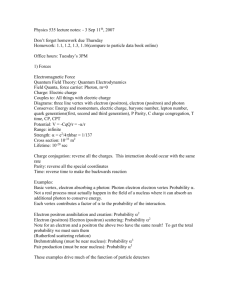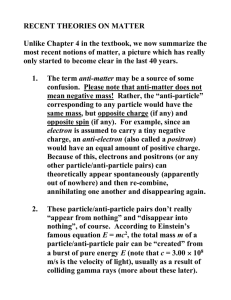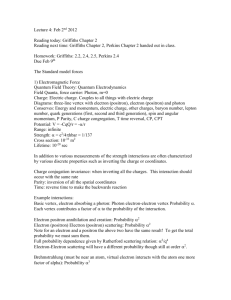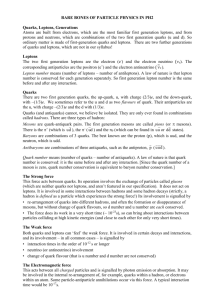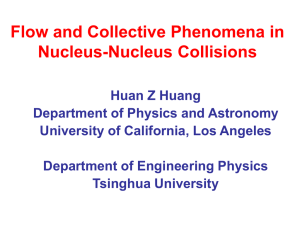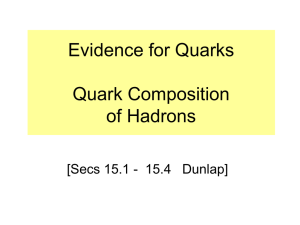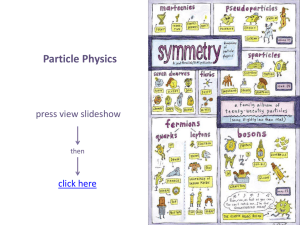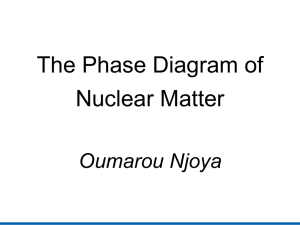lecturenotes2012_03
advertisement
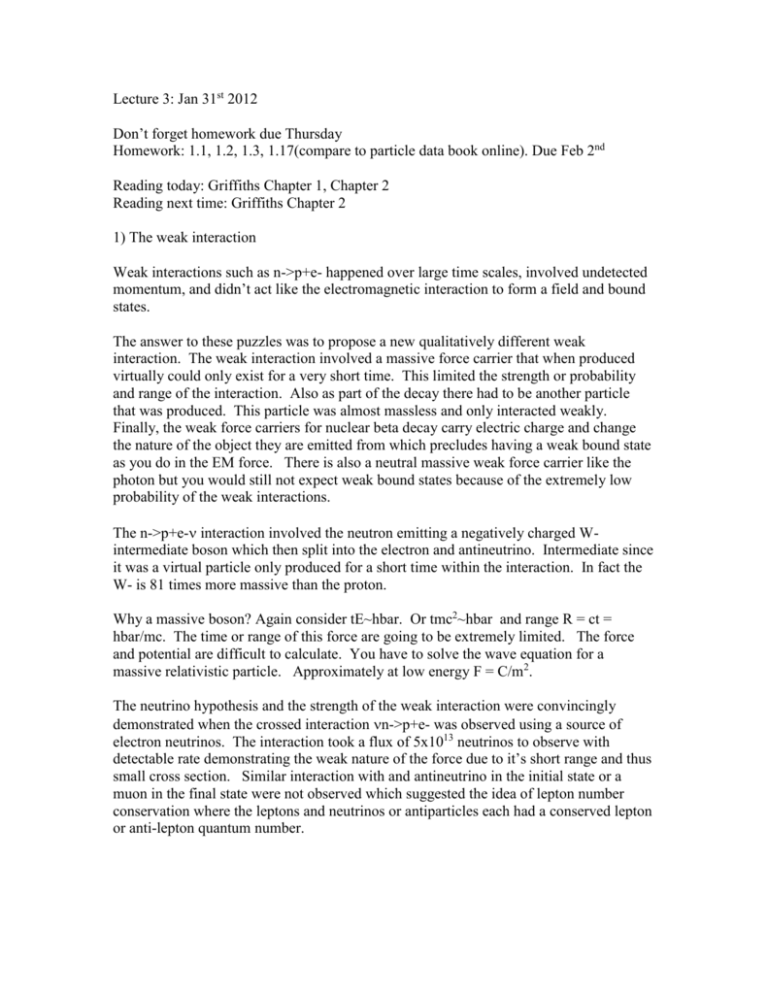
Lecture 3: Jan 31st 2012 Don’t forget homework due Thursday Homework: 1.1, 1.2, 1.3, 1.17(compare to particle data book online). Due Feb 2nd Reading today: Griffiths Chapter 1, Chapter 2 Reading next time: Griffiths Chapter 2 1) The weak interaction Weak interactions such as n->p+e- happened over large time scales, involved undetected momentum, and didn’t act like the electromagnetic interaction to form a field and bound states. The answer to these puzzles was to propose a new qualitatively different weak interaction. The weak interaction involved a massive force carrier that when produced virtually could only exist for a very short time. This limited the strength or probability and range of the interaction. Also as part of the decay there had to be another particle that was produced. This particle was almost massless and only interacted weakly. Finally, the weak force carriers for nuclear beta decay carry electric charge and change the nature of the object they are emitted from which precludes having a weak bound state as you do in the EM force. There is also a neutral massive weak force carrier like the photon but you would still not expect weak bound states because of the extremely low probability of the weak interactions. The n->p+e- interaction involved the neutron emitting a negatively charged Wintermediate boson which then split into the electron and antineutrino. Intermediate since it was a virtual particle only produced for a short time within the interaction. In fact the W- is 81 times more massive than the proton. Why a massive boson? Again consider tE~hbar. Or tmc2~hbar and range R = ct = hbar/mc. The time or range of this force are going to be extremely limited. The force and potential are difficult to calculate. You have to solve the wave equation for a massive relativistic particle. Approximately at low energy F = C/m2. The neutrino hypothesis and the strength of the weak interaction were convincingly demonstrated when the crossed interaction n->p+e- was observed using a source of electron neutrinos. The interaction took a flux of 5x1013 neutrinos to observe with detectable rate demonstrating the weak nature of the force due to it’s short range and thus small cross section. Similar interaction with and antineutrino in the initial state or a muon in the final state were not observed which suggested the idea of lepton number conservation where the leptons and neutrinos or antiparticles each had a conserved lepton or anti-lepton quantum number. For the muon you could observe the weak decay ->e- where the neutrinos were muon and anti-electron types. We could tell there where a electron and muon type of antineutrinos from observing p+ -> +n and p+ -> e+n. So the rules of the weak interaction were that it conserved lepton number (separately for electrons and muons and their neutrinos)(and electric charge) and relativistic momentum and energy. The interacting was short range, low probability or strength, decays had long time scales and the force was too weak to form bound states. 2) The strong force and the SM However what bound the quarks together? They were charged and even closer together so should experience massive electromagnetic attractive and repulsive forces. The quantum field theory with these features was Quantum cromodynamics. In QCD the gluon carries the strong force, which interacts with things that have strong or color charge. Note that all three forces involve a charge and fundamental particles with the proper charge can interact via that force. One proof of the color charge is the existence of the Delta uuu fermion, where all three quarks are spin up, which to obey Fermi statistics must have each quark in a different color state. A second proof of this theory comes from very high energy scattering experiments. Deep inelastic scattering experiments have probed the structure of the proton and see the quarks and infer gluons based on the momentum carried by the quarks. Inelastic because the energy is high enough that we tend to blow apart the proton. A third proof comes measuring calculating the probability for the W boson to decay to a quark and an antiquark. The probability is 3 times larger than expected because there are three possible final statues corresponding to the 3 color anti-color combination. The strong force was also limited in range, but by a difference mechanism. Instead of having a massive force carrier the gluon carries color charge itself and can interact with itself, which has the end result of limiting the range of the force. It also gives us other features such as confinement of the quarks to groups of 2 or 3. Calculating the potential you get V=-C/r +kr with the constant being near 1! This leads to the interesting effect that it’s more probable to have interactions with lots of gluons that with just one. Because of the linear term as quarks separate they build up so much potential energy when quarks separate that either they are “confined” by being attracted back together, or the energy is large enough eventually that you “pop” new quark-antiquark pairs out of the vacuum converting the energy of the potential to mass. The linear term physically can be thought of as a string of gluons stretching between the quarks. When the string breaks it’s energy goes into making two new quarks which will be near the old quarks. If it doesn’t break the quarks are pulled back into the hadron, or confined. So the rules of the strong interactions were that it conserved color charge number (and the other charges) and relativistic momentum. Also the interaction was very short range, high enough probability to be easily observed and result in decays of extremely short time scales and also strong enough to form bound states between particles like quarks(or protons) and exceed the EM repulsion between those objects. The short range we due to the fact that the force carrier had charge not an intrinsic property of individual interaction, which should be long range since the gluon is mass less. 1) The Standard model forces Electromagnetic Force Quantum Field Theory: Quantum Electrodynamics Field Quanta, force carrier: Photon, m=0 Charge: Electric charge. Couples to all things with electric charge Diagrams: three-line vertex with electron (positron), electron (positron) and photon Conserves: Energy and momentum, electric charge, other charges, baryon number, lepton number, quark generations (first, second and third generation), spin and angular momentum, P Parity, C charge congregation, T time reversal, CP, CPT Potential: V = -CqQ/r = -/r Range: infinite Strength: = e2/4hbar = 1/137 Cross section: 10-33 m2 Lifetime: 10-20 sec In addition to various measurements of the strength interactions are often characterized by various discrete properties such as inverting the charge or coordinates. Charge conjugation invariance: when inverting all the charges. This interaction should occur with the same rate Parity: inversion of all the spatial coordinates Time: reverse time to make the backwards reaction Example interactions: Basic vertex, electron absorbing a photon: Photon electron-electron vertex Probability . Each vertex contributes a factor of to the probability of the interaction. Electron positron annihilation and creation: Probability 2 Electron (positron) Electron (positron) scattering: Probability 2 Note for an electron and a positron the above two have the same result! To get the total probability we must sum them. Full probability dependence given by Rutherford scattering relation: 2/q4 Electron-Electron scattering will have a different probability though still at order 2. Brehmstrahlung (must be near an atom, virtual electron interacts with the atom one more factor of alpha): Probability 3 Pair production (must be near nucleus, virtual electron interacts with nucleus): Probability 3 Note on the single vertex process. Not a real process must actually happen in the field of a atom where it can absorb an additional photon to be relativistically allowed. Each vertex contributes a factor of to the probability of the interaction. In this case the interaction with the atom does not contribute a factor of alpha since the electron involved in such a process is orbiting very close to the nucleus and the probability of interaction with the nucleus in a reasonable time period is essentially one. These examples drive much of the function of particle detectors An interesting property: The virtual photons radiating from a charged particle can split into electrons and positrons and then annihilate back to a photon. These charges will orient with the positron toward the original charge (if negative) and the electron away from the charge. This effect, which is like a dielectric medium, tends to screen the original charge. As a result the effective coupling constant changes, becoming larger depending on how close you get to the original charge and smaller further away. We would say the coupling constant runs. Strong Force Quantum Field Theory: Quantum Chromo Dynamics Field Quanta, force carrier: 8 gluons , m=0 Charge: red green and blue color charge, 8 gluons carry different combinations of color anti-color Couples to: quarks and gluons Diagrams: three line vertex with quark (anti quark), quark (anti quark) and gluon, or three gluons Conserves: Energy and momentum, electric charge, color charge, other charges(lepton number quark flavor/generation), baryon number, spin and angular momentum, C, P, T, CP, CPT Potential: V =- s/r + kr Range 10-15 m – by confinement of color neutral combinations Strength: s = 1.3 (1.3 at 0.217GeV low energy, 0.3 at 1 GeV mid energy, 0.1 at 100 GeV high energy) (EM 1/137) Cross section: 10-30 m2 (EM 10-33) Lifetime: 10-23 sec (EM 10-20 sec) Examples Strong quark annihilation… Note quark annihilation would also have a contribution from the electromagnetic force but it is so small compared to the strong contribution that it can usually be ignored. Scattering via a gluon These interactions explain the behavior of hadrons in dense matter particle detectors. Interesting effects. Virtual gluons can split into quarks or gluons and annihilate back to gluons. This effect tends to anti-screen. A bare quark would radiate a strong color field attracting other quarks. Until you have 3 (red green blue) or 2 (color anti-color) you don’t have a stable color neutral system. In fact as small distances inside hadrons the strength of the strong force is very small. Small enough that perturbation theory works and in fact quark inside a nucleon are essentially free – asymptotic freedom. As you get very close to the quark(takes very small wavelengths or high energy) the coupling constant get very small. Near EM level. A hint of Unification? If momentum is transferred to one of the quarks in this system the kr part of the potential will pull back the quark back. In terms of a potential this can be thought of as due to the strong color field. If the quark has enough momentum the gluon string between the quarks will build up enough energy to form two new quarks. The new configuration of two new quark and shorter gluon strings has a lower potential. Note: nucleons are held together by the residual color charge just as molecules are held together by the residual electric charge outside of the otherwise electrically neutral atoms. Weak Force Quantum Field Theory: Quantum Flavor dynamics Field Quanta, force carrier: W+ and W- m=81GeV and Z m=91GeV Charge: Weak flavor charge. Lepton number, quark flavor Couples to: All things with flavor charge (all the quarks and leptons) Diagrams: W, three line vertex with electron neutrino and W or quark quark and W. Three line vertex with lepton anti-lepton or quark anti-quark and Z. Conserves: Energy and momentum, electric charge, lepton number, color charge, baryon number, CPT Violates: quark generation (W only, no flavor changing neutral current involving the neutral Z), C, P, CP(at a very small level) Potential: V = -W/r = -/M(W,Z)2r. Another hint of Unification Range: 10-18 Strength: W = 10-5(EM 1/137) Cross section: 10-44 m2(EM 10-33) Lifetime: 10-8 sec or longer EM 10-20 sec) Examples: Same types of diagrams as for the other two forces but now the W (not the Z) changes particle types. The weak force involves a large number in interactions with all the quark and leptons since they all have flavor. When determining what sort of interactions are possible or probable the guiding rules are that the interactions should conserve momentum and energy, electric charge and various types of weak flavor when appropriate. Some example interactions are d-> uW- -> ue- anti e: seen for neutrons, n(ddu) -> p(duu) e- antie - -> W- -> e- anite d anti u -> W- -> e- anti e: seen for charged pions - -> e- anti e s -> uW- -> ue- anti e: seen for charged kaons, for K-(s anti u) -> 0(u anit u) e- antie changes generations. Flavor changing between the quark generations can be explained by the idea that the three down type particles d, s, and b and the three up type particles u, c, and t are eigenstates of the strong force, but that the eigenstates of the weak force are slightly different for the down type particles d’, s’ and b’ which can be expressed as a linear combination of the d, s and b strong eigenstates. These coefficients can be summed up in the 3x3 CKM rotation matrix. Consider the b quark. When the b quark is in a meson or baryon coupled to other particles by gluons so it is definitely in a strong eigenstate. Therefore, it is in some superposition of d’, s’, and b’. When it interacts with the W+ it might interact as any of the three with a probability governed by the components of the linier combination it is in (CKM matrix) The W particle would convert b’ to t’ type eigenstates(particles) b(-1/3) -> W- t(2/3) with highest probability, but this decay is forbidden since the t quark is much more massive than the b quark If it interacts as a d’ what you will see is -> W- u or if a s’ what you will see is -> W- c. Therefore there is a finite probability of decaying to a c or a u quark. t is forbidden by energy conservation. According to the CKM matrix constants c is much more likely. This is the only way a particle from second and third generation can decay to the lowest energy generation. These particles all have long lifetime and in fact hadrons with b quarks have very long lifetimes since the b transitions to the other generations have small probabilities. The superposition of b’, s’, d’ for the b quark is mostly b’. The neutral Z particles have scattering and annihilation or pair production interactions much like the photons. Though these interactions can also involve neutrinos. Flavor changing between the generations like B->Zd is not possible for the Z particle. This can be understood mathematically. The W an interaction can be written as <u|WUCKM|s>, where a s strong eigenstate has some probability of being in a d’ weak eigenstate and being converted to a u quark. The matrix U is unitary because it conserves probability. For the Z, <d|U+ZU|s>, where U+ is the complex transform of U. However, U doesn’t act on the Z since it isn’t a quark and U+ZU = Z, and <d|Z|s> has zero probability since d and s are orthogonal eigenstates. Note FCNC, flavor changing neutral currents does happen at higher order at very low probability through higher order diagrams. Note that the weak boson couple to each other also but the interactions are very low probability so you don’t see them very often. They don’t lead to interesting new effects like in QCD.

